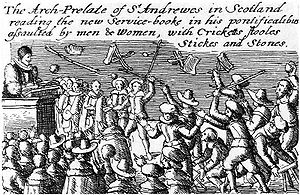The battle is set out as a mini-campaign around the
only major battle of the Bishops War, at Newburn Ford. the battle will be played
out over five games, with each game feeding into the other-so that if a unit of
two dragoons appears in the first scenario, get killed off, but i due to appear
in the 5th scenario, they remain dead, thus sewing a seed of doubt
at the back of the commanders mind needing to conserve troops for later use.

Background
Amid widespread opposition to Charles I’s imposed
Episcopalianism and New Book of Common Prayer on a dominant Scots’ Presbyterian
Population in 1637, the population of Southern Scotland signed the National
League and Covenant and raised an army. Outstripping anything the King could
raise, its officer corps blooded in Sweden and the Low Countries, the Scots’
emerged victorious from the short lived First Bishops War, with two ignominious
standoffs at Kelso and Duns Law. However Charles was not one to sit idle for
long and conflict would continue. To pre-empt Charles, the Covenanters must
invade first.

Reaching the lowest crossing point on the River
Tyne, the Covenanter forces under Sir Alexander Leslie could effectively bottle
in the coal trade coming out of Newcastle, from the weak southern defences, hampering
any Royalist opposition before it could even muster. Outnumbering their
Royalist opposition by 7:1, the Covenanters held all the negotiating cards.

A Royalist detachment from the garrison of Newcastle
under Lord Conway, had initially ensconced themselves at the ford. He had been
ordered personally by the Earl of Strafford to give battle to the Scots by any
means necessary. John Rushworth wrote;
...
were drawn forth into a plain Meadow ground which was near a mile in length,
close on the South side of [the] Tyne, called Newborne-Haugh or Stella-Haugh,
to hinder the Scots from passing the River in the night time, where were two
several Sconces or Breast-works raised by the English against the two Fords,
which the Scots might pass over at Low water, for till then they could not pass
the Tyne, and into each Sconce were put four hundred Musqueteers and four
pieces of Ordinance.
The
Horse were drawn into Squadrons in the said Haugh at some distance from the
Foot, in this posture Horse and Foot guarded the River all that night and the
next day, till the engagement.
The
Scots all the forenoon watered their Horses at one side of the River, and the
English on the other side, without affronting one another or giving any
reproachful language.

Sir
Alexander Leslie
Captain Thomas Dymock wrote;
Their
army appeared marching on the hills above the ford when we were drawing into
our miserable works in the valley, where we lay so exposed to their battery,
that their great shot was bowled in amongst our men, to their great loss.
John Rushworth on the Scot’s dispositions;
The Scots, having the advantage of the rising ground above
Newbourne, easily discerned the posture and motion of the English Army
below in the Valley on the Southside the River, but the posture of the Scots
Army the English could not discern, by reason of the Houses, Hedges, and
Inclosures in and about Newbourne. The Scots brought some Cannon into
Newbourne Town, and planted some in the Church Steeple a small distance from
the River Tyne, their Musqueteers were placed in the Church, Houses, Lanes and
Hedges in and about Newbourne.
At midday on
the 28th, Leslie sent forward a herald to give terms, assuring Conway of no ill
will on his part, wishing to petition the King. Conway agreed to a small party,
but not the whole army. The herald was taunted away by the Royalist pickets.


Looking
from the Scots positions at Ryton, down onto the battlefield
At 1pm, with the tide falling, a Scottish officer,
wearing a black feather in his bonnet, rode into the river. He was shot down
immediately. This prompted Leslie into an initial advance led by 300 Covenanter
horse.

How
it played out
Played out on a 120cm2 table, victory
depended on routing the other army from the field. Caught in an immediate
crossfire, options were limited to the four units of Covenanter Dragoons. Note,
you will notice many of them depicted in redcoats throughout the article, this
was due to the 1640 issue for Monroes Scot’s Army for Ireland being
issued with them-they are likely to have worn out very quickly.
However initial initiative failures on the part of
Conway’s forces, commanded by yours truly, meant that ample time was provided
for the dragoons to find cover within the ample tree line on the far side of
the Tyne. But, still being too far away from the Royalist earthworks, no pot-shots
could to be taken at their opposing gun teams. Any river crossing will slow
down an army’s progress and this would be no different. Call it Cole’s
crossing, 17th century style.
However, succeeding on initiative the following turn
and successfully rolling to fire, a round shot barrelled into Leven’s unit.
Only one casualty was inflicted, but this was crucial when rolling to inflict a
lucky blow, it became apparent that Leven had had his head taken off-curtailing
any further military reputation at Marston Moor! All subsequent units passed
their initiative, but with their commander out for six, stopped for that turn.
A further shot barrelled into Leven’s dragoons, taking out another three, but
they remained intact.
The following turn, provided a bit of welcome
release to the Covenanters, with both guns now reloading, and the Royalist foot
trying to invert, to provide covering fire once the dragoons got across the
Tyne. However failed initiative from Monck’s company meant this was only partly
achieved. However initially this would not matter, advance now being slowed by
the dragoons wandering from the woods and venturing into the tide.
This would be most felt as again a raging crossfire,
forced all but one unit back across the river, Leven’s own dragoons being wiped
out. But rallying, Montrose’s successfully got across and in and amongst the
earthworks, delivering a point blank volley at Monck’s company and wiping it
out before the guns and infantry could pivot to meet this threat. Applied use
of massed volleys and hailshot being used to wipe the Covenanter threat from
the field.
Will they have a chance to build a successful bridgehead
to finally take out the guns? Find out next month.
Sources:
Guest, K and D. British
Battles: The Frontlines of History in Colour Photographs (HarperCollins/EH,
1994)
Leck, M. “Weapon’s for the Rebels: The Swedish
Influence on the Battle of Newburn” Wargames,
Soldiers and Strategy 87 (Karwansaray Publishing, Zutphen, 2016)
English
Heritage Battlefield Report: Newburn Ford 1640 (London,
1995) DOI: https://content.historicengland.org.uk/content/docs/battlefields/newburn.pdf





